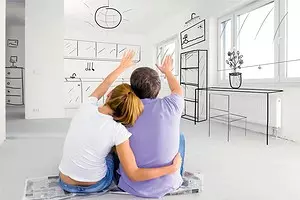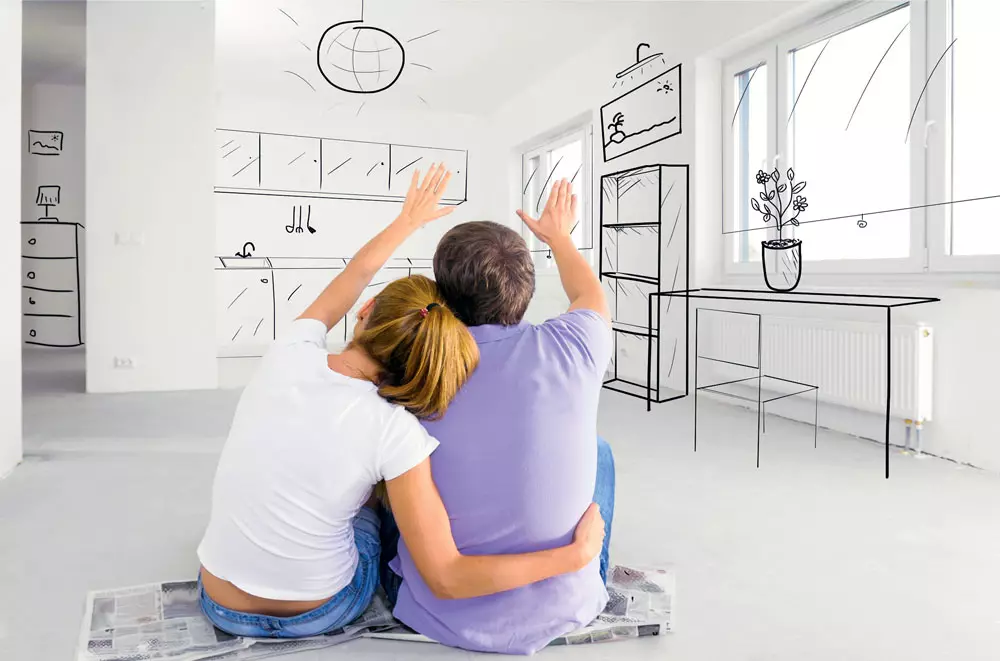Apartments without inner walls, or, as they are also called, with free layout, appeared in the real estate market for a long time. However, developers, realtors and potential buyers still relate to them ambiguously.


Photo: Legion-Media
By buying an apartment with a free layout, it is necessary to understand that this freedom is conditional - still have to build the walls and agree on changes in all instances.
Freedom without wall
It should be noted that the terms "Free Planning", "Conditionally Free Planning", "Semi-Free Planning", which often use realtors to describe their real estate, are absent in Russian legislation.
The potential owner who was offered housing with a free layout, imagines a dream apartment - with large windows, personal fireplace, bathroom in Polbasin wide, but you never know what other dreams are ...
In fact, free layout implies a semi-finished apartment. The buyer receives a living space limited only by outer walls. The inner walls are either marked by a pair of rows of bricks (foam blocks), or drawn by a dotted line on the Plan of BTI; The apartment has a layout of the floor to heating radiators, communications were carried out (most often they are hidden in brick or foam blocks), fire alarms and a built-in ventilation system are provided. Clearly designated only borders of the kitchen and bathrooms - the so-called wet areas.
From the point of view of the developer, the lack of walls is equivalent to essential savings on building materials. The rough finish of the built housing, or rather, to say, the boxes of the house, can do about the same amount as its construction. For this reason, the developer will be happy to offer developers and realtors to divide the residential fund into two parts - apartments with free layout and ordinary.
Subsequently, the wall in the semi-finished product will be erected by the wall or restrict ourselves to pylons or columns that will allow a slightly increase in the living area (and not only visually expand the space). It is important to understand that the "dream apartment" looks unsightly in concrete, and its metrah seems significantly less than the stated area.

Photo: Photo 5000 / Fotolia.com
Be vigilant when buying an apartment with a free layout on the secondary market: all the walls erected (or not erected) by the previous owner must be legalized and marked in the BTI documents. Otherwise, you will have to make redevelopment, besides, such an apartment is unlikely to be able to resell without loss of value
The essential difficulty is that architects cannot assume how free planning is needed by the future owners of housing in the house designed by them. However, in a floor plan, which the developer transmits to BTI, there are already walls, the load is designed, the degree of insolation of the premises is indicated, the zones of the bathroom and kitchen are clearly highlighted, the built-in wardrobes and dark storage rooms are indicated. For this reason, the buyer of the apartment with free planning should immediately lay on its budget expenses not only for the services of a designer and workers who will implement the proposed project, but also on the approval of the latter in the heading.The first houses with apartments "not like everyone else" appeared in Moscow in the late 90s. last century. After housing was bought in the building built along the new formwork (monolithic) technology at that time, from 80 to 90% of apartments were redesigned with a complete or partial demolition of internal non-rigorous walls. In the following homes, the developers began to offer apartments with erected inner walls and without walls, but with a coordinated typical project, thereby saving on construction materials, and on wages of workers. However, those first, apartments are most often implemented before gentlemen and transferring documents to the technical inventory bureau. The developers were beneficial to sell not only an apartment, but also their services to legitimize the project developed by the client, since there was an opportunity to finalize the plan for each buyer. The necessary changes were made to the working draft, and after the house of the state commission, the owner immediately received documents for housing.
Today, companies are not ready to work with each customer, and therefore it is necessary to repel from the construction (floor) plan - it can be obtained either from the developer or in the management company. The plan is fully marked, which was agreed and passed to the StateExpertiz before the construction. The phased plan is confirmed by the seal of the developer and is provided in the hill scope together with the main set of documents.
Pros and cons
Before proceeding to the intricacies of the Project Leading Procedure, it is worth noting once again what opportunities free planning provides the buyer. Unlike the finished housing, where the elevated walls will have to break the flight of their own fantasy, the semi-finished apartment will allow you to do without a long, quite expensive, as well as an extremely dusty and dirty stage of work. Another positive aspect is associated with the initial price of the apartment. Since the walls were not erected, it costs a little cheaper than the neighboring, fully completed by the project.
Unfortunately, such an apartment will deliver a lot of trouble. The owner will have to invite a designer, develop and coordinate the project, find workers,
And then accepted for the implementation (there may be problems if the intention comes against the construction and sanitary standards, designed to ensure the safety of the building and tenants). According to developers, at the end of all works and coordination, the actual cost of a square meter sometimes increases twice.
Electricity in homes where housing is offered with a free layout, it is customary to let down only for the distribution shield of the apartment, but not to introduce inside, because the issue of electrification usually becomes one of the most burning when re-planning. It is worth checking out the heat wiring, since in some cases the central heating batteries are also set at the discretion of the host (within the capacity set by the Customer's project). Stock vote at such a moment: the area of the apartment area of the apartment is almost twice as fewer areas (since there are no corridors and other auxiliary premises). This means that almost any project has insolation restrictions, because it is possible to expand residential space only by the part of the apartment that will have insufficient natural lighting. It is difficult to agree on such a project, and the accounts for the electricity supply will be simply huge.
If you rely on Avos, without issuing redevelopment, then the "freedom-loving" or poorly informed owner of the apartment can be prosecuted by law, especially if the reorganization will be damaged to a neighborhood or generalicity or, even worse, life and health of the neighbors.

Photo: Legion-Media
The owner of the apartment, the redevelopment of which is not issued in the prescribed manner (or is made with violation of the requirements), is responsible in accordance with the norms of legislation. In addition, he is obliged to bring the room in the former state (before reorganization) or coordinate the work performed
The hillpox is entitled to demand an apartment to a state, fixed in the BTI Plan. If during the examination (expensive and long-term) it will be proved that redevelopment does not entail any threats, the Court may allow to leave the dwelling in a renewed and (or) rejected form. However, in advance to foresee the outcome of the consideration of the case is extremely difficult, and the preparation for the court will deliver a lot of trouble.As developers believe, today, when buying an apartment in a typical new building, it is better to choose already planned and fully completed housing, having received a passport, which is decorated for all the rules of BTI. If you are ready to spend and want to make the original layout, be extremely attentive. Request a copy of a floor plan from the developer, consult your designer, follow the initial calculation of the project. Or choose a house where typical layout is simply not provided, and each apartment is built taking into account the wishes of the customer - there are such proposals in the real estate market too.
We receive documents
Project development, inspection of premises, drawing up a technical conclusion about the status of structures and the possibility of redevelopment, obtaining the conclusion of Rospotrebnadzor and the approval of the project in the amount takes at least 2-3 months. In addition to the project, you will need a copy of the passport, a statement about the coordination of the reorganization and redevelopment, a copy of the right-pointing documents for an apartment, the technical passport of the dwelling, the written consent of the owners.
Having obtained the resolution of the hill scope, you can proceed to the implementation of the project. After all the work is completed, it is necessary to testify the end of the end of redevelopment in the hillside (the reception of hidden works is produced during the repair process), then get a new plan in the BTI, and then a certificate of ownership of an apartment with an individual planning. Documentary paperwork will take about 2 months.
Given the difficulties, developers are ready to abandon free planning and offer to buyers several options for ready and agreed layouts for the same apartments.
Consider cannot be banned

Photo: Legion-Media
We will remind our readers, which activities on redevelopment of residential premises do not need to receive permission, what work it is necessary to coordinate with high-quality specialists, and what interference in the initial project of the developer is prohibited, since it is dangerous for residents of an apartment building.
Permission will not need if you plan:
- make cosmetic premises, including replacing finishing coatings of walls, floors, ceilings, exterior joinery elements without changing pattern and colors;
- to build or dismantle the built-in furniture (cabinets, mezzanine), not forming independent rooms (this area is not subject to technical accounting);
- Replace (without permutation) Engineering equipment similar by parameters and technical device;
- Move household floor electric stove within the kitchen room;
- Mount the external technical means (antennas, protective grids and air conditioners) on the facades of apartment buildings;
- Install self-regulating or carousel doors and showcases from light-scale designs without changing the external dimensions of the premises;
- replace the materials and change the plastic of external structures, balconies and loggias;
- Rearrange heating (heating) and gas devices (while installing and rearrangement of gas appliances
- with laying additional supply networks are prohibited);
- Replace the joinery elements of the facade of the building (with a change in drawing).
The following works can be carried out, and then issue permission (in a simplified, notification order):
- Reinstall plumbing devices within room of toilets, bathrooms, kitchens;
- to close the doorways in the undesupply partitions;
- glazed loggias and balconies for typical projects;
- eliminate tambura or change their form without increasing external dimensions;
- Lower the inner partitions without increasing loads on overlap;
- Disassemble (fully or partially) undesiprectic partitions (excluding intercounty);
- Make loops in undesupply partitions (except for intercouqu).
- The project can also be performed by those types of work that affect the supporting structures, general engineering communications, not mentioned in the two previous lists.
It is strictly prohibited:
- worsen the conditions of operation of the house and residence of citizens, including difficulty access to engineering communications, disconnecting devices, etc.;
- Rebut rooms or related rooms, if after performing work they will become unsuitable for living;
- disrupt the strength and stability of the supporting structures of the building, which is why the latter can collapse;
- Installing disconnecting or regulating devices on general (general-welded) engineering networks, if using them can affect resource consumption in related rooms;
- eliminate or reduce the cross-section of natural ventilation channels;
- Increase the load on the supporting structures over the permissible on the project (calculation of the bearing ability, by deformations) when applying the screeds in the floors, replacing partitions
- from lung materials on structures of heavy materials,
- as well as place additional equipment;
- transfer the heating radiators connected to the general water supply system or central heating, in the loggia, on balconies and veranda;
- Mount the heated floors from the general-purpose systems of hot water supply and heating;
- violate the requirements of construction, sanitary and hygienic, operational standards and fire safety rules for apartment buildings;
- Construct the purses, cut down the niches, punch holes
- in pylons walls, diaphragm walls and columns (racks, pillars), as well as in places of connectivity between prefabricated elements;
- arrange fines in horizontal seams and under the inner wall panels, as well as in wall panels and plates of overlaps for placing electrical wiring, pipeline wiring (in typical houses);
- shut down loggias and terraces on the second and above floors;
- rebuild and (or) redeem the attic, the technical floor belonging to the total property of the owners of the premises;
- carry out work on reorganization or redevelopment
- in buildings recognized by emergency;
- carry out work affecting the appearance of the appearance of houses, including building mansard windows, as well as change the dimensions of residential premises (for cultural heritage sites);
- arrange the pasists between residential rooms and gasified kitchens without a tightly closing door;
- Combine a gasified room with residential.
